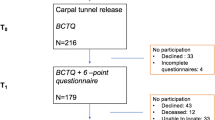Abstract
Surgical treatment of carpal tunnel syndrome (CTS) is used over the world with reported good results. The long-term rehabilitation result in terms of postoperative difficulties in returning back to work after surgery, however, has not been carefully studied. Ninety-three consecutive patients under the age of 55 were followed up 2 years after they had carpal tunnel surgery. Thirty-eight patients had symptoms similar to the ones that caused the operation; 24 patients in the study had monotonous, repetitive jobs. Of those, there were 18 that still had symptoms in the operated hand and 12 were incapable of work, meaning they were on long-term sick leave or had early retirement pensions. This study indicates that further measures than surgery alone are needed to get some patients with CTS back to a long-term working life. This is most obvious in females who after carpal tunnel surgery, return to a job exposing them to repetitive, monotonous hand and arm movements.
Similar content being viewed by others
References
Silverstein BA, Fine LJ, Armstrong TJ. Occupational factors and carpal tunnel syndrome.Am J. Ind. Med 1987, 11: 343–358.
Ferguson D: RSI. Putting the epidemic to rest.Med. J. Austr. 1987, 147: 213–214.
Borg K, Lindblom U. Finger numbness—a 10 percent incidence among Swedish grownups.Sw J Med Assoc 1982, 26–27 25 (in Swedish).
Armstrong TJ: An ergonomic guide to carpal tunnel syndrome,Am Ind Hyg Assoc J 1983.
Cannon LJ, Bernacki EJ, Walter SD. Personal and occupational factors associated with carpal tunnel.JOM 1981, 23: 255–258.
Lundborg G, Gelberman RH, Minteer-Conery M, Fonteu Y, Hargens AR. Median nerve compression in the carpal tunnel—functional response to experimentally induced controlled pressure.J Hand Surg 1982, 7: 252–259.
Hybbinette C-H, Mannerfelt L. The carpal tunnel syndrome. A retrospective study of 400 operated patients.Acta Orthop Scand 1975, 46: 610–620.
Schipper H. Editorial.Can Med Assoc j 1983; 128: 1367.
Hagberg M, Wegman DH. Prevalence rates and odds ratios of shoulder-neck diseases in different occupational groups.Br J Ind Med 1987, 44: 602–610.
Onishi N, Namura H, Sakai K, Yamamoto T, Hirayama K, Hani T. Shoulder muscle tenderness and physical features of female industrial workers.J Human Ergol 1976; 5: 87–102.
DeKrom MCTFM, Knipschild PG, Kester ADM, Spaans, F. Efficacy of provocative tests for diagnosis of carpal tunnel syndrome.Lancet 1990; 335: 393–395.
Redmond MD, Rivner MH. False positive electrodiagnosis in carpal tunnel syndrome.Muscle Nerve 1988; 10: 511–517.
Dahlin LB, Nordborg C, Lundborg G. Morphological changes in nerve cell bodies induced by experimental graded nerve compression.Exp Neurol 1987; 95: 611–621.
Thorngren K-G, Werner CO. Normal grip strength.Acta Orthop Scand 1979: 50: 255–259.
Gellman H, Kan D Gee V, Kuschber SH, Botte MJ. Analysis of pinch and grip strength after carpal tunnel release.J Hand Surg 1989; 14 (A): 863–865.
Edwards RHT, Newham DJ, Jones DA, Chapman SJ. Role of mechanical damage in pathogenesis of proximal myopath in man.Lancet 1986; 10: 548–551.
Author information
Authors and Affiliations
Rights and permissions
About this article
Cite this article
Parenmark, G., Alffram, PA. & Malmkvist, AK. The significance of work tasks for rehabilitation outcome after carpal tunnel surgery. J Occup Rehab 2, 89–94 (1992). https://doi.org/10.1007/BF01079015
Issue Date:
DOI: https://doi.org/10.1007/BF01079015




